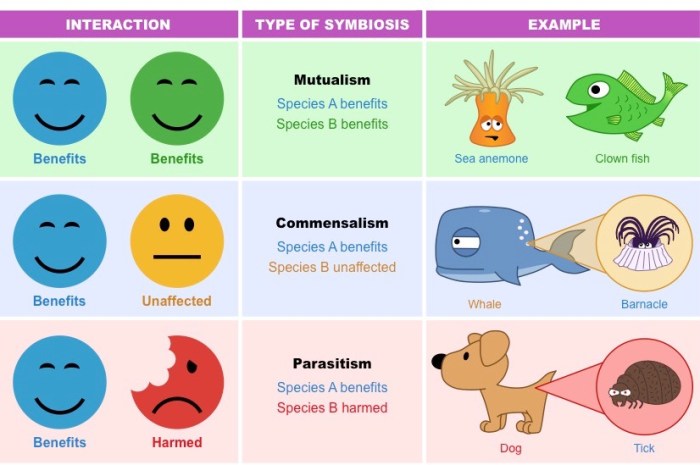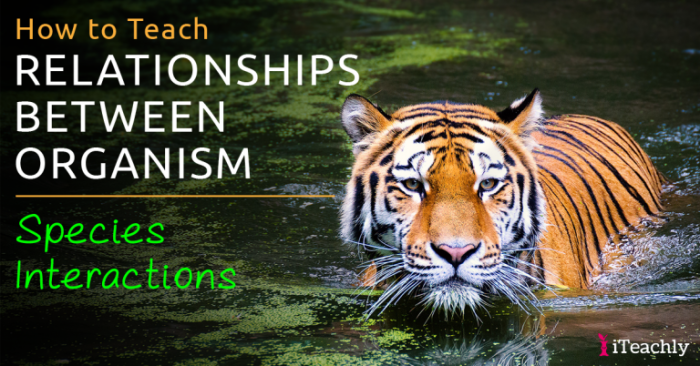Embark on an intriguing journey with the Organism Interaction and Relationships WebQuest, where we delve into the fascinating world of ecological interactions. This webquest unveils the intricate web of relationships that governs the coexistence of diverse organisms within ecosystems.
Discover the nuances of competition, predation, and symbiosis, exploring their significance and the factors that shape their dynamics. Trace the threads of a web of relationships, unraveling the roles of keystone species and trophic levels in maintaining ecosystem balance. Delve into the complexities of food chains and food webs, understanding their crucial role in ecosystem stability.
Organism Interactions
Organisms interact with each other in various ways, shaping the dynamics and stability of ecosystems. These interactions can be classified into different types based on their effects on the organisms involved.
Competition
- Occurs when organisms utilize the same limited resources, such as food, water, or space.
- Can lead to aggressive behavior, resource partitioning, or competitive exclusion.
- Example: Lions competing for prey in a savanna.
Predation
- Involves one organism (predator) capturing and consuming another (prey).
- Plays a crucial role in regulating population sizes and maintaining ecosystem balance.
- Example: Cheetahs preying on gazelles.
Symbiosis
- A close and long-term relationship between two different species.
- Can be mutualistic (beneficial to both species), commensalistic (beneficial to one species and neutral to the other), or parasitic (harmful to one species and beneficial to the other).
- Example: Lichens (a mutualistic relationship between fungi and algae).
Web of Relationships
Organisms in an ecosystem are interconnected through a complex network of relationships known as a web of relationships.
Keystone Species
- Species that have a disproportionately large impact on their ecosystem relative to their abundance.
- Their removal or decline can lead to significant changes in the ecosystem.
- Example: Sea otters, which prey on sea urchins and prevent them from overgrazing kelp forests.
Trophic Levels
- Hierarchical levels within a food web based on feeding relationships.
- Producers (plants) are at the base, followed by primary consumers (herbivores), secondary consumers (carnivores), and so on.
- Each level depends on the level below for energy and nutrients.
Impact of Human Activities
- Human activities can disrupt the web of relationships through habitat destruction, pollution, and overexploitation.
- These disruptions can have cascading effects on ecosystem stability and biodiversity.
- Example: Deforestation leading to the decline of canopy-dwelling species and altered nutrient cycling.
Food Chains and Food Webs

Food chains and food webs depict the feeding relationships among organisms in an ecosystem.
Food Chain
- A linear sequence of organisms, each of which feeds on the one below it.
- Energy flows from producers to consumers and ultimately to decomposers.
- Example: Grass → Grasshopper → Bird → Hawk.
Food Web
- A complex network of interconnected food chains.
- Reflects the multiple feeding relationships within an ecosystem.
- Example: A food web in a forest ecosystem involving trees, insects, birds, and mammals.
Importance of Food Chains and Food Webs
- Maintain ecosystem stability by regulating population sizes and nutrient cycling.
- Provide insights into the flow of energy and nutrients through an ecosystem.
- Help identify vulnerable species and potential impacts of environmental changes.
Predator-Prey Relationships

Predator-prey relationships are dynamic interactions that regulate population sizes and shape ecosystem dynamics.
Population Regulation, Organism interaction and relationships webquest
- Predators reduce prey populations, preventing overpopulation and resource depletion.
- Prey populations can recover when predator populations decline.
- Example: The predator-prey cycle between lynx and snowshoe hares.
Strategies of Predators and Prey
- Predators:Camouflage, ambush, speed, and group hunting.
- Prey:Cryptic coloration, mimicry, escape behaviors, and warning signals.
- Example: The camouflage of stick insects and the warning colors of poison dart frogs.
Ecosystem Impact
- Predator-prey relationships maintain species diversity and ecosystem balance.
- The removal of predators can lead to “trophic cascades,” where prey populations explode and negatively impact lower trophic levels.
- Example: The decline of wolves in Yellowstone National Park led to an increase in elk populations, resulting in overgrazing and habitat damage.
Symbiotic Relationships: Organism Interaction And Relationships Webquest

Symbiotic relationships involve close and long-term interactions between different species.
Mutualism
- Both species benefit from the relationship.
- Example: Mycorrhizal fungi and plant roots, where the fungi provide nutrients to the plant and receive carbohydrates in return.
Commensalism
- One species benefits while the other is neither harmed nor benefited.
- Example: Barnacles attaching to whale skin, gaining protection and mobility.
Parasitism
- One species (parasite) benefits at the expense of the other (host).
- Parasites can weaken or kill their hosts, but some have evolved to minimize harm to ensure their own survival.
- Example: Tapeworms living in the intestines of animals.
Evolutionary Significance
- Symbiotic relationships have played a crucial role in the evolution of organisms.
- They have enabled species to adapt to new environments, exploit new resources, and increase their fitness.
- Example: The co-evolution of flowering plants and pollinating insects.
Questions and Answers
What is the significance of keystone species?
Keystone species play a disproportionately large role in maintaining the structure and function of an ecosystem relative to their abundance. Their removal or decline can have cascading effects on other species and the entire ecosystem.
How do predator-prey relationships regulate population sizes?
Predator-prey relationships act as a natural check on population growth. Predators reduce prey populations, preventing overpopulation and allowing other species to access resources. Prey species, in turn, adapt to avoid predation, driving evolutionary changes and maintaining a dynamic balance.
What are the different types of symbiotic relationships?
Symbiotic relationships encompass mutualism, commensalism, and parasitism. Mutualism benefits both species, commensalism benefits one species without harming the other, and parasitism benefits one species at the expense of the other.